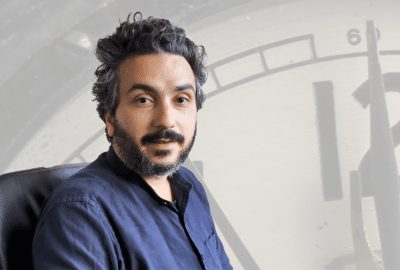Another Case of Heart Trouble
Tuesday 2nd Oct 2012, 4.30pm
Our bodies aren’t really powered by apparatus like that shown in our animation, but the molecular machines do work in similar ways. Here’s a little more background on exactly what’s going on.
DNA encodes instructions
When Ossie enters John’s body and travels to the cells in his heart, he lands on a string of deoxyribonucleic acid (DNA). DNA is a set of coded instructions of four chemicals, represented by the letters A, T, C and G. Each instruction is known as a gene. In the nucleus of a cell, a section of DNA is transcribed by an enzyme called RNA polymerase. This creates a messenger molecule, ribonucleic acid (RNA), which leaves the nucleus through nuclear pores and travels to structures called ribosomes, found in a region of the cell called the endoplasmic reticulum. The ribosomes carry out the process of translation where the RNA is ‘read’ and used as the instruction to make a protein product. Usually one gene gives the instructions to make one protein product. If there is a flaw in the gene caused by a ‘spelling mistake’ in the DNA – a mutation – the ribosome will create an altered protein product which might not function very well, or it might not do its job at all.
Genes and inheritance
DNA is stored in chromosomes, which are made up of thousands of genes. We have 22 chromosomes which come in pairs – we get one half of each pair from each of our parents – and these are called autosomes. This means that we have two copies of each of the ‘autosomal’ genes carried on these chromosomes. The 23rd pair of chromosomes determines whether you are male or female, and these are called the sex chromosomes. Males have an X chromosome and a Y chromosome, and females have two X chromosomes.
Two types of inheritance are associated with mutations in autosomal genes. In conditions which show autosomal dominant inheritance, a mutation in one copy of the gene is sufficient to cause disease in the person who carries it. Having a second functioning copy of the gene is not enough to compensate for the mutated copy. When we make eggs or sperm we only pass on one copy of each gene, and this happens randomly. This means there is a 50%, or 1 in 2, chance that a person carrying a mutation in one copy of a gene will pass on that mutated copy of the gene to their children. On average, half of their children will inherit the condition.
In autosomal recessive inheritance, a mutation in one copy of the gene does not usually cause the person carrying it any problems. The second functioning copy can compensate, and this person is often called a ‘carrier’ if the mutation is identified in them. Only when someone inherits two mutated copies of the gene – one from each parent – do they cause disease. Because there is a 50% chance that a carrier parent will pass on the mutated copy of the gene, if a child has parents who are both carriers, there is a 25%, or 1 in 4, chance that the child will inherit two mutated copies of the gene and be affected by the condition.
Inherited heart conditions and autosomal dominant inheritance
Hypertrophic Cardiomyopathy (HCM) is the heart problem shown in the animation. It’s one of the genetic conditions which can cause young, apparently well, people to collapse and die suddenly. HCM is caused by a fault in the muscle cells which make up the heart. Muscle is a molecular motor made up of lots of different proteins including actin and myosin. Subtle mutations, that usually just change a single amino acid (missense mutations), in one of a number of different heart muscle protein genes can cause HCM. In each family just one mutation causes the condition, but the number of different mutations amongst different families with the condition is large. We believe that the HCM-causing mutations cause the muscle to contract in an inefficient way – a way that uses up too much energy, which comes in the form of a chemical called adenosine triphosphate (ATP). This inefficiency can cause the muscle to thicken as a way of compensating, but this in turn can decrease the size of the pumping chambers of the heart. The heart cannot then pump enough blood around the body and an affected person may experience shortness of breath or chest pain. The thickened heart muscle can also be more prone to irregular heartbeats as it runs out of ATP, and this can cause the collapse that we see in John as his heart goes into a fast, uncontrolled rhythm called ventricular fibrillation. Although most people with HCM are at low risk, if ventricular fibrillation does occur it will be rapidly fatal unless the heart can be restarted by a DC current electrical shock (called cardioversion). Tragically, HCM is often unrecognized and as a result is the commonest cause of sudden cardiac death in young adults.
HCM is inherited in families in an autosomal dominant manner. This means that each of the children of an affected person have a 1 in 2 chance of inheriting the mutation which causes HCM. The condition can be very variable within families and not everyone with the same mutation will be affected in the same way. We think that the variability in the types of symptoms people experience is due to other genes and the environment interacting with the HCM-causing mutation which runs in the family
This is illustrated in the animation. John’s cousin was the person in whom HCM was first identified in the family – he experienced symptoms which affected his ability to play football. He inherited the mutation which caused his HCM from his mother, who is John’s aunt. John’s own father also carries the mutation, and therefore one of John’s grandparents must also carry the mutation and have passed it to both John’s father and his aunt. However, we hear that both John’s father and his aunt have had their hearts checked and they are not at high risk of having dangerous heart rhythms.
John had his heart checked because of his family history and was found to have some uncontrolled heart rhythms – known as arrhythmias – which put him at risk of collapsing suddenly. He had an Implantable Cardioverter Defibrillator (ICD) fitted, which is able to shock his heart back into a normal rhythm if it detects ventricular fibrillation.
Genetic testing for patients and families
When a person like John’s cousin is first seen by doctors who specialise in inherited heart conditions, as well as thinking about how to look after the patient, the doctors aim to inform the patient’s relatives that they could also have HCM. Before genetic testing was available, they would recommend that relatives have screening tests such as an electrocardiogram (ECG) which checks the electrical signals controlling the heart, and an echocardiogram which checks the structure of the heart using ultrasound, similar to methods used to look at unborn babies. These tests are not always effective at detecting HCM, however.
John’s cousin can be offered genetic testing to see if it is possible to identify which gene is mutated and causing HCM in him. Sometimes a mutation can’t be found and all the relatives can be offered screening tests instead. If a mutation is identified, genetic testing can be offered to other members of the family to see if they also carry the mutation. Relatives who carry the mutation then have the screening tests as part of regular follow-up care, and medication or an ICD if they need it. Relatives who don’t carry the mutation don’t need to have any further tests, as they won’t be at high risk of developing HCM.
Genetics in Oxford
The Oxford Radcliffe Hospitals Trust is able to offer genetic testing to patients with HCM. This test currently looks for mutations in any of 14 genes, all of which encode heart muscle proteins, where mutations have been shown to cause HCM. There are likely to be more genes which can also be mutated to cause HCM, but while they remain unknown they can’t be tested for. Some of these genes were first identified by Oxford scientists as being genes that specifically cause HCM. Through collaboration between the research lab at Oxford University and the Oxford Molecular Genetics lab in the hospital, Oxford has led the way in offering genetic testing for inherited heart conditions within the UK. Also, the mechanisms by which HCM-causing mutations in these genes disturb the heart’s function has been better understood through research done at Oxford and doctors are beginning to test new forms of medical treatment.
Further information:
Teaching Resources:
KS4: A Heartfelt Dilemma (contact us)
Find out more:
Information on inherited heart disease from Oxford
Howard Hughes Medical Institute animations of each part of the Central Dogma
Telling Stories: Understanding Real Life Genetics – from the NHS
Guardian story about Lisa Corke, who has an abnormality in her heart’s electrical system
Hands-on DNA: test your own DNA in this hands-on workshop for schools






